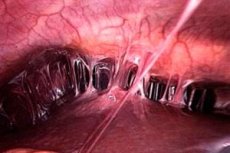Medical expert of the article
New publications
Inflammatory disease of the uterus
Last reviewed: 23.04.2024

All iLive content is medically reviewed or fact checked to ensure as much factual accuracy as possible.
We have strict sourcing guidelines and only link to reputable media sites, academic research institutions and, whenever possible, medically peer reviewed studies. Note that the numbers in parentheses ([1], [2], etc.) are clickable links to these studies.
If you feel that any of our content is inaccurate, out-of-date, or otherwise questionable, please select it and press Ctrl + Enter.

Inflammatory disease of the uterus - infectious and inflammatory diseases of the upper female genital tract, including the uterus, fallopian tubes, and adjacent anatomical structures of the pelvis.
Infection and inflammation can spread to the abdominal organs, including perineal structures (Fitz-Hugh-Curtis syndrome).
Causes of the inflammatory diseases of the uterus
Chlamydia trachomatis is the predominant pathogen of inflammatory diseases of the uterus. Other microorganisms are gonococci, vaginal gardnerella, hemophilic infection, Mycoplasma Hominis, herpes simplex viruses 2, trichomonads, cytomegaloviruses and anaerobes (Peptococcus and Bacteroides). Laparoscopic studies have shown that in 30-40% of cases of infection, the flora is polymicrobial.
Risk factors
The high-risk group includes women under the age of 25 who have multiple sexual partners and do not use contraception. The development of inflammatory diseases of the uterus is facilitated by complicated abortions, childbirth, diagnostic curettage of the uterus, hysterosalpingography and other intrauterine interventions, especially those that do not take into account the state of the microflora of the vagina or with violation of the rules of aseptic and antiseptic.
Symptoms of the inflammatory diseases of the uterus
Acute endometritis is characterized by deterioration of the general condition, fever, sometimes chills, tachycardia. Patients are concerned about pain in the lower abdomen and in the sacrum. Discharge from the genital tract is mucopurulent, cloudy, often with an unpleasant odor. When a vaginal examination, a moderately enlarged tender uterus of a soft consistency is determined (after birth and abortion, a subinvolution of the uterus is often detected).
The main symptoms of chronic endometritis are menstrual irregularity - menorrhagia (hypermenorrhea, polymenorrhea), as well as spotting after menstruation, aching pain in the lower abdomen, sacrum and lower back. There is a moderate increase and consolidation of the uterus, a restriction of its mobility (due to fusion with neighboring organs - perimetritis).
Forms
Inflammatory diseases of the uterus include:
- endometritis - inflammation of the mucous membrane of the uterus;
- endometriometritis - inflammation of the mucosa and myometrium;
- Panmetritis is an inflammatory process that covers all layers of the uterus.
Complications and consequences
Inflammatory disease of the uterus can be complicated by the development of tubo-ovarian abscess, diffuse peritonitis and Fitz-Hugh-Curtis syndrome.
The main consequences are:
- Chronic pelvic pain. It occurs in about 25% of patients. This pain is believed to be associated with cyclic menstrual changes, the presence of adhesions or hydrosalpinx
- Infertility and impaired fertility. Infection and inflammation can lead to the formation of scars and uterine adhesions.
- Ectopic pregnancy. The risk of developing an ectopic pregnancy increases by 15-50%.
Diagnostics of the inflammatory diseases of the uterus
Diagnosis of the disease is based on taking into account anamnestic data and clinical manifestations. The blood test data correspond to the inflammatory process. Bacteriological study of excretions from the uterus allows to identify pathogens and establish their sensitivity to antibiotics.
What do need to examine?
Differential diagnosis
Differential diagnosis includes appendicitis, cervicitis, urinary tract infections, endometriosis, adnexa tumors and ectopic pregnancy.
Who to contact?
Treatment of the inflammatory diseases of the uterus
In acute process, patients are hospitalized. In a hospital, a cold on the lower abdomen, sanation of the focus of infection is prescribed.
Washing of the uterus with cold solutions of antiseptics), carrying out complex conservative therapy. After childbirth and abortions necessarily use funds that cut the uterus.
Treatment of chronic inflammatory diseases of the uterus includes, as a rule, the use of physiotherapy procedures, balneotherapy, as well as tools that increase the immunological reactivity of the body. Effectively the appointment of ultrasound, electrophoresis of medicinal substances (iodine, zinc), therapeutic mud, paraffin, ozocerite, radon waters (baths, irrigation).


 [
[